This page contains DirectX 9.0 Software Development Kit Update (Summer 2003).
Note: Latest DirectX SDK (April 2005 Update - at writing time) located under this link
Move to desired DirectX SDK part:
Info field below contains Name / Date / Size with links to file and
description field contains some notes about sample and screenshot from run-time.
DirectX headers and libraries
| Info |
Description |
|
|
Delphi headers adaptation followed by Borland and JEDI standarts for all (up to 9.0) versions of
DirectDraw, Direct3D, DirectInput, DirectSound, DirectMusic; DirectPlay8 (updated to DirectX9);
D3DX 9.0 headers with support library; dxerr9 (DirectX 9.x error reporting) headers with support library.
In this file you'll find JEDI compliant version and preprocessed
versions of headers for Delphi 4/5 and Delphi 6/7. Also this archive contains simple example of
Direct3D8 program.
This package DOES NOT include any helper libraries like D3DX (D3DX9Sab.DLL) or DXErr -
error reporting (DXErr9ab.DLL).
Download it.
|
|
|
Subset of previous translation. Includes only PAS files compatible with JEDI standarts from
Clootie_DirectX90.exe.
Download it.
|
|
|
DLLs needed for both Delphi and C++ Builder, to use D3DX 9.0 functionality and/or DXErr (DirectX error
reporting) in your projects or compile Microsoft demos: D3DX9Sab.dll, DXErr9ab.DLL.
Download it.
|
Also here you can find DirectX libraries required for
compiling Direct3D 9.0 applications with C++ Builder.
Direct3D examples from DirectX SDK
Notes: All examples can be compiled either in Delphi or C++ Builder.
Please read "How to compile ObjectPascal
DirectX examples" page containing instructions how to compile examples in either Delphi or
C++Builder with additional details.
| Info |
Description |
|
|
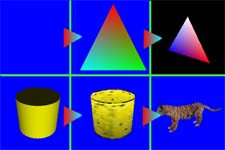
6 "step by step" DirectX tutorials. Great tutorials to start learning
Direct3D. From initializing D3D device renderer to loading meshes.
These tutorial do not need any additional files to compile and run. Only headers and D3DX helper dll for some of tutorials.
Download them all at once (source with executables and media files).
|
|
|
|
Translated Sample DirectX Framework - used by all Direct3D/DirectSound examples.
Includes: D3DApp, D3DEnumeration, D3DFile, D3DFont, D3DRes, D3DSettings, D3DUtil, DSUtil, DXUtil files.
There are Direct3D files (D3DSaver) what still need Delphi conversion...
Also DDUtil unit (DirectDraw utilities) is included - initially converted by Dominique Louis.
Download it.
|
|
|
|
|
 The BasicHLSL sampleshows a simple example of the High-Level Shader Language (HLSL) using an effect
interface smoke, explosions, and more. This sample simply loads a mesh, creates an effect from a file, and then uses
the effect to render the mesh. The effect that is used is a simple vertex shader that animates the vertices based
on time.
The BasicHLSL sampleshows a simple example of the High-Level Shader Language (HLSL) using an effect
interface smoke, explosions, and more. This sample simply loads a mesh, creates an effect from a file, and then uses
the effect to render the mesh. The effect that is used is a simple vertex shader that animates the vertices based
on time.
Download it (archive contains source, media files, EXE).
|
|
|
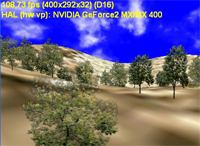 The Billboard sample illustrates the billboarding technique. Rather than
rendering complex 3D models (such as a high-polygon tree model),
billboarding renders a 2D image of the model and rotates it to always face
the eyepoint.
The Billboard sample illustrates the billboarding technique. Rather than
rendering complex 3D models (such as a high-polygon tree model),
billboarding renders a 2D image of the model and rotates it to always face
the eyepoint.
This technique is commonly used to render trees, clouds,
smoke, explosions, and more.
Download it (archive contains source, EXE).
|
Blobs.zip
09-Feb-2004
279Kb
Free Pascal compatible
|
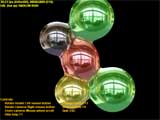 The Blobs sample mimics a metaball effect in screen space using a pixel shader. True metaball techniques deform
surfaces according to pushing or pulling modifiers, and are commonly used to model liquid effects like the merging of
water droplets; however, metaball effects can be computationally expensive, and this sample shows how to fake a 3D
metaball effect in 2D image space using a pixel shader.
The Blobs sample mimics a metaball effect in screen space using a pixel shader. True metaball techniques deform
surfaces according to pushing or pulling modifiers, and are commonly used to model liquid effects like the merging of
water droplets; however, metaball effects can be computationally expensive, and this sample shows how to fake a 3D
metaball effect in 2D image space using a pixel shader.
More extensive documentation can be found in Readme.html in sample archive.
Download it (archive contains source, EXE and media files).
|
|
|
Bumpmapping folder contains 4 demos (and lacks 3 others). These demos demostrate various
techniques of applying bump-mapping on objects: EMBP, emboss, Dot3.
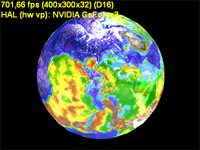
The BumpEarth sample demonstrates the bump mapping capabilities of Direct3D.
Bumpmapping is a texture blending technique used to render the appearance of
rough, bumpy surfaces. This sample renders a rotating, bumpmapped planet Earth.
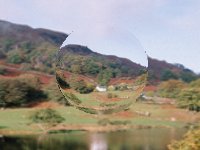 The BumpLens sample demonstrates a lens effect that can be acheived using
bumpmapping. Bumpmapping is a texture blending technique used to render the
appearance of rough, bumpy surfaces, but can also be used for other effects
as shown here.
The BumpLens sample demonstrates a lens effect that can be acheived using
bumpmapping. Bumpmapping is a texture blending technique used to render the
appearance of rough, bumpy surfaces, but can also be used for other effects
as shown here.
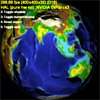
This BumpSelfshadow sample includes all source and content for the self shadowing
bump map algorithm presented at the 2001 GDC lecture by Dan Baker and Chas Boyd.
Presentatin itself can be found here.
This app will run without pixel shaders, as long as the hardware has rendertargets and DOT3.
However, it runs much more efficently with pixel shaders and with better visual results.
 The BumpUnderwater sample demonstrates an underwater effect that can be
acheived using bumpmapping. Bumpmapping is a texture blending technique used
to render the appearance of rough, bumpy surfaces, but can also be used for
other effects as shown here.
The BumpUnderwater sample demonstrates an underwater effect that can be
acheived using bumpmapping. Bumpmapping is a texture blending technique used
to render the appearance of rough, bumpy surfaces, but can also be used for
other effects as shown here.
Download it (archive contains only source files).
|
|
|
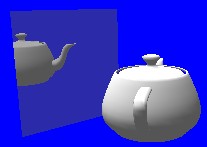 The ClipMirror sample demonstrates the use of custom-defined clip planes.
A 3D scene is rendered normally, and then again in a 2nd pass as if reflected
in a planar mirror. Clip planes are used to clip the reflected scene to the
edges of the mirror.
The ClipMirror sample demonstrates the use of custom-defined clip planes.
A 3D scene is rendered normally, and then again in a 2nd pass as if reflected
in a planar mirror. Clip planes are used to clip the reflected scene to the
edges of the mirror.
Download it (archive contains source, EXE and media files).
NOTE: This sample is no longer included in original MS DirectX SDK.
|
|
|
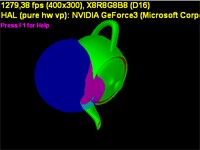 The ClipVolume sample demonstrates a technique for using shaders to
"subtract" a sphere from an arbitrary model when rendering. This technique
could be useful in visualization applications to see inside complex objects.
The sample also shows how to perform two-sided lighting and pixel level clipping via texkill.
The ClipVolume sample demonstrates a technique for using shaders to
"subtract" a sphere from an arbitrary model when rendering. This technique
could be useful in visualization applications to see inside complex objects.
The sample also shows how to perform two-sided lighting and pixel level clipping via texkill.
Download it (archive contains source, EXE and media files).
|
|
|
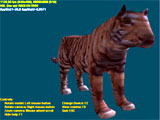 The CompiledEffect sample shows how an ID3DXEffect object can be compiled when the project is built and loaded
directly as a binary file at run time. This sample can be treaded like BasicHLSL modified to use precompiled EffectFile.
The CompiledEffect sample shows how an ID3DXEffect object can be compiled when the project is built and loaded
directly as a binary file at run time. This sample can be treaded like BasicHLSL modified to use precompiled EffectFile.
Download it (archive contains source, EXE and media files).
|
|
|
The Cull sample illustrates how to cull objects whose object bounding box (OBB) does
not intersect the viewing frustum. By not passing these objects to Microsoft®
Direct3D®, you save the time that would be spent by Direct3D transforming and lighting
these objects, which will never be visible. The time saved could be significant if there
are many such objects or if the objects contain many vertices.
 More elaborate and efficient culling can be done by creating hierarchies of objects, with
bounding boxes around groups of objects, so that not every object's OBB has to be compared
to the view frustum.
More elaborate and efficient culling can be done by creating hierarchies of objects, with
bounding boxes around groups of objects, so that not every object's OBB has to be compared
to the view frustum.
It is more efficient to do this OBB/frustum intersection calculation in your own code than
to use Direct3D to transform the OBB and check the resulting clip flags.
You can adapt the culling routines in this sample meet the needs of programs that you write.
Download it (archive contains source and EXE files).
|
|
|
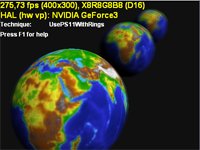 The DepthOfField sample shows a technique for creating a depth-of-field effect with
Direct3D, in which objects are only in focus at a given distance from the
camera, and are out of focus at other distances.
The DepthOfField sample shows a technique for creating a depth-of-field effect with
Direct3D, in which objects are only in focus at a given distance from the
camera, and are out of focus at other distances.
Sample uses FX effect-file to drive rendering for different hardware / techniques. Techniques include PixelShader 1.1,
PixelShader 1.4 and PixelShader 2.0 variations with HLSL (High Level Shading Language) and assembler implementations.
Download it (archive contains source, EXE and media files).
|
|
|
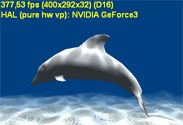 The DolphinVS sample shows an underwater scene of a dolphin swimming, with
caustic effects on the dolphin and seafloor. The dolphin is animated using
a technique called "tweening". The underwater effect simply uses fog, and
the water caustics use an animated set of textures. These effects are
achieved using vertex shaders
The DolphinVS sample shows an underwater scene of a dolphin swimming, with
caustic effects on the dolphin and seafloor. The dolphin is animated using
a technique called "tweening". The underwater effect simply uses fog, and
the water caustics use an animated set of textures. These effects are
achieved using vertex shaders
Download it (archive contains source, EXE).
|
|
|
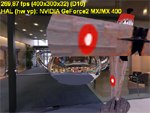 The CubeMap sample demonstrates an environment mapping technique called cube mapping.
Environment mapping is a technique in which the environment surrounding a 3-D object, such
as the lights, is put into a texture map, so that the object can have complex lighting
effects without expensive lighting calculations.
The CubeMap sample demonstrates an environment mapping technique called cube mapping.
Environment mapping is a technique in which the environment surrounding a 3-D object, such
as the lights, is put into a texture map, so that the object can have complex lighting
effects without expensive lighting calculations.
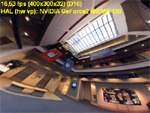 The FishEye sample shows a fish-eye lens effect that can be achieved using cube maps.
The FishEye sample shows a fish-eye lens effect that can be achieved using cube maps.
 The SphereMap sample demonstrates an environment mapping technique called sphere
mapping. Environment mapping is a technique in which the environment surrounding a 3-D
object, such as the lights, are put into a texture map, so that the object can have complex
lighting effects without expensive lighting calculations.
The SphereMap sample demonstrates an environment mapping technique called sphere
mapping. Environment mapping is a technique in which the environment surrounding a 3-D
object, such as the lights, are put into a texture map, so that the object can have complex
lighting effects without expensive lighting calculations.
NOTE: This sample is no longer included in original MS DirectX SDK.
Download them (archive contains source, EXE files).
|
|
|
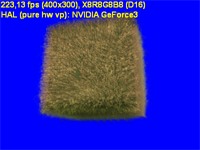 The Fur sample shows how to do real-time fur rendering. This sample implementation is tied to cube
but contains all the code and media files to render any other fur meshes. Sample do not require hi-end hardware and should be
run even on TNT-class video cards - only with vertex shader code processed by CPU.
The Fur sample shows how to do real-time fur rendering. This sample implementation is tied to cube
but contains all the code and media files to render any other fur meshes. Sample do not require hi-end hardware and should be
run even on TNT-class video cards - only with vertex shader code processed by CPU.
Download it (archive contains source, EXE and media files).
|
|
|
 The HDRCubeMap sample demonstrates cubic environment-mapping with floating-point textures and high
dynamic range lighting. In DirectX 9.0, floating-point formats have become available for textures. These formats can
store color values higher than 1.0, which can make lighting effects more realistic on the environment-mapped mesh when
the material absorbs part of the light.
The HDRCubeMap sample demonstrates cubic environment-mapping with floating-point textures and high
dynamic range lighting. In DirectX 9.0, floating-point formats have become available for textures. These formats can
store color values higher than 1.0, which can make lighting effects more realistic on the environment-mapped mesh when
the material absorbs part of the light.
Note that not all cards support all features for the environment-mapping and high dynamic range lighting techniques.
Download it (archive contains source and EXE).
|
|
|
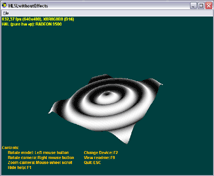 This HLSLWithoutEffects sample shows an example of how to use Microsoft Direct3D's High-Level Shader
Language (HLSL), without the use of the Direct3D Extension (D3DX) effect interfaces. Not using the ID3DXEffect
interface is a more difficult method of using HLSL. See the BasicHLSL sample for a simpler method of using HLSL.
This HLSLWithoutEffects sample shows an example of how to use Microsoft Direct3D's High-Level Shader
Language (HLSL), without the use of the Direct3D Extension (D3DX) effect interfaces. Not using the ID3DXEffect
interface is a more difficult method of using HLSL. See the BasicHLSL sample for a simpler method of using HLSL.
Download it (archive contains source and EXE).
|
|
|
 The Lighting samples shows how to use D3D lights when rendering. It shows the difference between
the various types of lights (ambient, point, directional, spot), how to configure these lights, and
how to enable and disable them.
The Lighting samples shows how to use D3D lights when rendering. It shows the difference between
the various types of lights (ambient, point, directional, spot), how to configure these lights, and
how to enable and disable them.
Download it (archive contains source and executable).
NOTE: This sample is no longer included in original MS DirectX SDK.
|
|
|
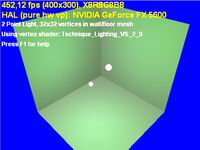 The LightingVS sample is an extension of the Lighting sample that adds
vertex shader implementations of lighting. It lets you add multiple lights
and compare the output and performance between the vertex shader lights
and the fixed-function pipeline lights.
The LightingVS sample is an extension of the Lighting sample that adds
vertex shader implementations of lighting. It lets you add multiple lights
and compare the output and performance between the vertex shader lights
and the fixed-function pipeline lights.
Download it (archive contains source and executable).
|
|
|
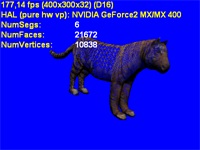
The EnhancedMesh sample shows how to use D3DX to load and enhance a mesh.
The mesh is enhanced by increasing the vertex count using N-Patch tesselation algorithm.
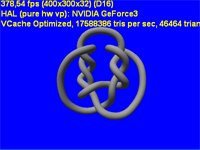
The OptimizedMesh sample illustrates how to load and optimize a file-based mesh
using the Microsoft� Direct3DX mesh utility functions.
 The ProgressiveMesh sample illustrates how to load and optimize a file-based mesh using the D3DX mesh utility
functions. A progressive mesh is one in which the vertex information is stored internally in a special tree which
can be accessed to render the mesh with any given number of vertices. This procedure is fast, so progressive meshes
are ideal for level-of-detail scenarios, where objects in the distance are render with fewer polygons.
The ProgressiveMesh sample illustrates how to load and optimize a file-based mesh using the D3DX mesh utility
functions. A progressive mesh is one in which the vertex information is stored internally in a special tree which
can be accessed to render the mesh with any given number of vertices. This procedure is fast, so progressive meshes
are ideal for level-of-detail scenarios, where objects in the distance are render with fewer polygons.
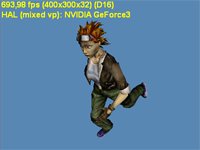 The Skinned Mesh sample demonstrates loading and parsing hierarhy of X-file frames using D3DX and using different
hardware & software ways to do skinning. Sample uses D3DX9 library mesh and animation extentions a lot. To note a few
of them: ID3DXSkinInfo, ID3DXAllocateHierarchy implementation, ID3DXAnimationController and corresponding D3DX functions.
The Skinned Mesh sample demonstrates loading and parsing hierarhy of X-file frames using D3DX and using different
hardware & software ways to do skinning. Sample uses D3DX9 library mesh and animation extentions a lot. To note a few
of them: ID3DXSkinInfo, ID3DXAllocateHierarchy implementation, ID3DXAnimationController and corresponding D3DX functions.
Download them (archive contains source, EXE and media files).
|
|
|
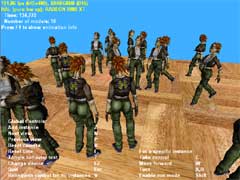 This MultiAnimation sample demonstrates mesh animation with multiple animation sets using HLSL skinning and D3DX's
animation controller. The animation controller blends animation sets together to ensure a smooth transition when moving
from one animation to another.
This MultiAnimation sample demonstrates mesh animation with multiple animation sets using HLSL skinning and D3DX's
animation controller. The animation controller blends animation sets together to ensure a smooth transition when moving
from one animation to another.
Download it (archive contains source, most media files and EXE).
|
|
|
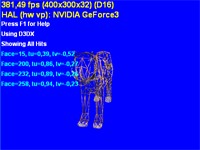 The Pick sample shows how to implement picking; that is, finding which triangle in a mesh is intersected by a ray. In this case, the ray comes from mouse coordinates.
The Pick sample shows how to implement picking; that is, finding which triangle in a mesh is intersected by a ray. In this case, the ray comes from mouse coordinates.
To do this inverse transform is calculated and triangle is searched in displayed mesh.
Download it (archive contains source, EXE and media files).
|
|
|
 The PixelMotionBlur sample shows how to do a post process motion blur effect using floating point textures, shaders
and multiple render targets. The first pass renders the scene's color to the first render target and writes the velocity
of each pixel to the second render target. It then does a post process pass using a pixel shader to blur the pixel based on
the pixel's velocity.
The PixelMotionBlur sample shows how to do a post process motion blur effect using floating point textures, shaders
and multiple render targets. The first pass renders the scene's color to the first render target and writes the velocity
of each pixel to the second render target. It then does a post process pass using a pixel shader to blur the pixel based on
the pixel's velocity.
Download it (archive contains source, EXE and some media files).
|
|
|
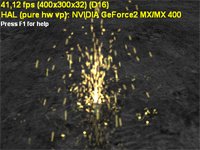 The PointSprites sample shows how to use the new Direct3D point sprites feature.
A point sprite is simply a forward-facing, textured quad that is referenced only by (x,y,z)
position coordinates. Point sprites are most often used for particle systems and related
effects.
The PointSprites sample shows how to use the new Direct3D point sprites feature.
A point sprite is simply a forward-facing, textured quad that is referenced only by (x,y,z)
position coordinates. Point sprites are most often used for particle systems and related
effects.
Note that not all cards support all features for point sprites. For more information on
point sprites, refer to the DirectX SDK documentation.
Download it (archive contains source, EXE and media files).
|
|
|
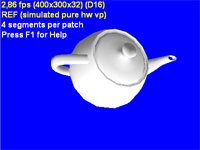 The RTPatch sample shows how to use patches in Direct3D - display meshes with API
"added" smothness.
The RTPatch sample shows how to use patches in Direct3D - display meshes with API
"added" smothness.
Note: RTPatches were originally integrated in DirectX 8 for NVIDIA GeForce3 support.
But starting from some driver version they are unsupported (IIRC starting from Detonator 20.XX series).
Download it (archive contains source and EXE, no media files needed).
|
|
|
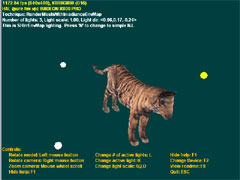 The SHIrradianceEnvMap sample shows how to use spherical harmonics to handle any number of lights in a single pass
with a simple shader.
The SHIrradianceEnvMap sample shows how to use spherical harmonics to handle any number of lights in a single pass
with a simple shader.
Download it (archive contains source, EXE, some media files).
|
|
|
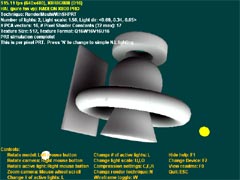 The SHPRTPixel sample is similar to the SHPRTVertex sample, this sample
demonstrates how use D3DXSHPRTSimulationTex(), a per texel precomputed radiance transfer (PRT) simulator that uses
low-order spherical harmonics (SH) and records the results to a file. The sample then demonstrates how compress the
results with principal component analysis (PCA) and views the compressed results with arbitrary lighting in real time
with a ps_2_0 pixel shader.
The SHPRTPixel sample is similar to the SHPRTVertex sample, this sample
demonstrates how use D3DXSHPRTSimulationTex(), a per texel precomputed radiance transfer (PRT) simulator that uses
low-order spherical harmonics (SH) and records the results to a file. The sample then demonstrates how compress the
results with principal component analysis (PCA) and views the compressed results with arbitrary lighting in real time
with a ps_2_0 pixel shader.
Download it (archive contains source, EXE, some media files).
|
|
|
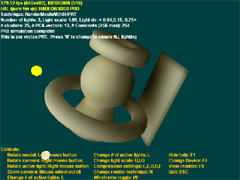 The SHPRTVertex sample is similar to the SHPRTPixel sample, this sample
demonstrates how use D3DXSHPRTSimulation(), a vertex based precomputed radiance transfer (PRT) simulator that uses
low-order spherical harmonics (SH) and records the results to a file. The sample then demonstrates how compress the
results with clustered principal component analysis (CPCA) and view the compressed results with arbitrary lighting in
real time with a vs_1_1 vertex shader.
The SHPRTVertex sample is similar to the SHPRTPixel sample, this sample
demonstrates how use D3DXSHPRTSimulation(), a vertex based precomputed radiance transfer (PRT) simulator that uses
low-order spherical harmonics (SH) and records the results to a file. The sample then demonstrates how compress the
results with clustered principal component analysis (CPCA) and view the compressed results with arbitrary lighting in
real time with a vs_1_1 vertex shader.
Download it (archive contains source, EXE, some media files).
|
|
|
Demos from StencilBuffer folder of DirectX SDK. These demos demostrate various usage
scenarious of stencil buffer.
Stencil buffers are a depth buffer technique that can be updated as geometry is rendered,
and used again as a mask for drawing more geometry. Common effects include mirrors,
shadows (an advanced technique), dissolves, etc..
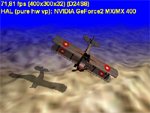
The ShadowVolume sample uses stencil buffers to implement real-time shadows. In the
sample, a complex object is rendered and used as a shadow-caster, to cast real-time shadows
on itself and on the terrain below.
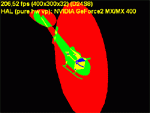
The StencilDepth sample uses stencil buffers to display the depth complexity of a
scene. The depth complextity of a scene is defined as the average number of times each
pixel is rendered to.

The StencilMirror sample uses stencil buffers to implement a mirror effect. In the
sample, a watery terrain scene is rendered with the water reflecting a helicopter that
flies above.
Download samples (archive contains source, EXE and media files).
|
|
|
 The Text3D sample uses ID3DXFont to display 2D text in a 3D scene. This is most useful for display stats,
in game menus, etc... Note: new revision of ID3DXFont support UNICODE character rendering, so sample demostrates
rendering of Japanese text (you should have installed Asian languages support to see them).
The Text3D sample uses ID3DXFont to display 2D text in a 3D scene. This is most useful for display stats,
in game menus, etc... Note: new revision of ID3DXFont support UNICODE character rendering, so sample demostrates
rendering of Japanese text (you should have installed Asian languages support to see them).
The sample also shows how to use D3DXCreateText() to create a D3DX mesh containing a 3D model of a text string.
Note that D3DXCreateText may not work with certain types of fonts, such as bitmap fonts and some symbol fonts.
Download it (archive contains source and EXE, no media files needed).
|
|
|
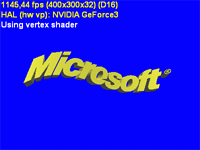 The VertexBlend sample demonstrates a technique called vertex blending (also known as
surface skinning). It displays a file-based object which is made to bend is various spots.
The VertexBlend sample demonstrates a technique called vertex blending (also known as
surface skinning). It displays a file-based object which is made to bend is various spots.
Initially this is Microsoft logo. Blending can be done with either Fixed finction pipeline
or with VertexShader.
Surface skinning is an impressive technique used for effects like smooth joints and bulging
muscles in character animations.
Note that not all cards support all features for vertex blending. For more
information on vertex blending, refer to the DirectX SDK documentation.
Download it (archive contains source, EXE and media files).
NOTE: This sample is no longer included in original MS DirectX SDK.
|
|
|
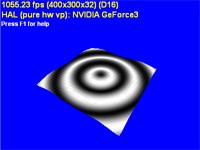 The VertexShader sample shows some of the effects that can be achieved using vertex
shaders. Vertex shaders use a set of instructions, executed by the 3D device on a per-vertex
basis, that can affect the properties of the vertex (positions, normal, color, tex coords,
etc.) in interesting ways.
The VertexShader sample shows some of the effects that can be achieved using vertex
shaders. Vertex shaders use a set of instructions, executed by the 3D device on a per-vertex
basis, that can affect the properties of the vertex (positions, normal, color, tex coords,
etc.) in interesting ways.
Note that not all cards may support all the various features vertex shaders. For more
information on vertex shaders, refer to the DirectX SDK documentation.
Download it (archive contains source, EXE and media files).
NOTE: This sample is no longer included in original MS DirectX SDK.
|
|
|
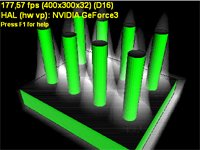 The Volume Fog sample shows the per-pixel density volumetric rendering technique.
The fog volume is modeled as a polygonal mesh, and the density of the fog at every pixel
is computed by subtracting the front side of the fog volume from the back side. The fog is
mixed with the scene by accumulating an in/out test at every pixel -- that is, back-facing
fog polygons will add, while front-facing ones will subtract. If the value is non zero,
then the scene intersects the fog and the scene's depth value is used. In order to get
better results, this demo uses 12 bits of precision by encoding high and low bits in
different color channels.
The Volume Fog sample shows the per-pixel density volumetric rendering technique.
The fog volume is modeled as a polygonal mesh, and the density of the fog at every pixel
is computed by subtracting the front side of the fog volume from the back side. The fog is
mixed with the scene by accumulating an in/out test at every pixel -- that is, back-facing
fog polygons will add, while front-facing ones will subtract. If the value is non zero,
then the scene intersects the fog and the scene's depth value is used. In order to get
better results, this demo uses 12 bits of precision by encoding high and low bits in
different color channels.
More info on this sample can be read in supplied readme.txt file. Also VolumeFog technique
is discussed in
this PowerPoint presentation showed by Daniel Baker at GDC 2002.
Download it (archive contains source and EXE).
PS. For people who still have not downloaded DirectX SDK - download X-files needed for this sample.
|
|
|
 The VolumeTexture sample illustrates how to use the new volume textures in Direct3D.
Normally, a texture is thought of as a 2D image, which have a width and a height and whose
"texels" are addressed with two coordinate, tu and tv. Volume textures are the 3D
counterparts, with a width, height, and depth, are are addressed with three coordinates,
tu, tv, and tw.
The VolumeTexture sample illustrates how to use the new volume textures in Direct3D.
Normally, a texture is thought of as a 2D image, which have a width and a height and whose
"texels" are addressed with two coordinate, tu and tv. Volume textures are the 3D
counterparts, with a width, height, and depth, are are addressed with three coordinates,
tu, tv, and tw.
Volume textures can be used for interesting effects like patchy fog, explosions, etc..
Note that not all cards support all features for volume textures. For more information on
volume textures, refer to the DirectX SDK documentation.
Download it (archive contains source and EXE, no media files needed).
|
|
|
 The Water sample illustrates using D3DX techniques stored in shader files.
The Water sample illustrates using D3DX techniques stored in shader files.
The sample shows a square pound inside a building, with rippling water
effects including water caustics.
Download it (archive contains source and EXE, no media files included).
|
DirectSound examples from DirectX SDK
| Info |
Description |
|
|
 The SoundFx sample shows how to use standard effects with DirectSound and
how to manipulate FX parameters. It is similar to the AudioFX sample but does not use an audiopath
(sorry, but there is no AudioFX Delphi sample... yet).
The SoundFx sample shows how to use standard effects with DirectSound and
how to manipulate FX parameters. It is similar to the AudioFX sample but does not use an audiopath
(sorry, but there is no AudioFX Delphi sample... yet).
Download it (archive contains source and EXE files).
|
DirectDraw examples from DirectX SDK
| Info |
Description |
|
|
These are DirectX 8.1 SDK DirectDraw examples. Note: MS is already not including any DirectDraw examples with DirectX 9 SDK!
Translated Sample DirectDraw samples - this archive contains
most of DirectDraw samples from DirectX 8.x SDK, originally produced as part of
DirectXExamples effort: AnimatePalette, DDEnum, DirectSurfaceWrite,
FullScreenDialog, FullScreenMode, GammaControl, OverlayAnimate, RefreshRate, SpriteAnimate,
SwitchScreenMode, WindowedMode. Also DDUtil.pas helper unit can be found in archive too.
NOTE: these samples are not supported and/or maintained by me.
Download them locally.
Download them from Yahoo Groups.
|
DirectX SDK Media files
Currently only DirectX 8.1 SDK media is available for download.
| Info |
Description |
|
|
These media files are provided for people who have not yet downloaded and installed DirectX
SDK. [Shame on you!!!] Ok, I understand what downloading about 200Mb can be paintfull, so
you have this download item.
Files on left panel contain (from top to bottom):
- Mesh (.x) files, Vertex Shaders and PixelShaders source files;
- Common textures;
- "MS Lobby" environment map textures used in: BumpUnderwater, CubeMap, FishEye,
SphereMap, Water samples;
- REG files - to allow you add information to Windows registry about where is SDK media
files are located (see readme.txt included for installation).
|
Original DirectX 9.0 SDK (Dec-2002) headers, libraries and samples (for backward compatibility)
| Info |
Description |
|
|
Delphi headers adaptation followed by Borland and JEDI standarts for all (up to 9.0) versions of
DirectDraw, Direct3D, DirectInput, DirectSound, DirectMusic; DirectPlay8 (updated to DirectX9);
D3DX 9.0 headers with support library; dxerr9 (DirectX 9.x error reporting) headers with support library.
In this file you'll find JEDI compliant version and preprocessed
versions of headers for Delphi 4/5 and Delphi 6/7. Also this archive contains simple example of
Direct3D8 program.
This package DOES NOT include any helper libraries like D3DX (D3DX9ab.DLL) or DXErr -
error reporting (DXErr9ab.DLL).
Download it.
|
|
|
Subset of previous translation. Includes only PAS files compatible with JEDI standarts from
Clootie_DirectX90.exe.
Download it.
|
|
|
DLLs needed for both Delphi and C++ Builder, to use D3DX 9.0 functionality and/or DXErr (DirectX error
reporting) in your projects or compile Microsoft demos: D3DX9ab.dll, DXErr9ab.DLL.
Download it.
|
|
|
Partioned version of D3DX9 library - contains separate parts of D3DX9 library in separate DLL's.
These DLLs can be used for both Delphi and C++ Builder, to use D3DX 9.0 functionality in your projects.
This is optinal download - don't download it if you don't know what to do with it!
Download it.
|
|
|
|
Archive contains Direct3D samples (including D3DFramework) from original SDK, released in December 2002.
Single self-extracting archive cantain all samples including: Billboard, ClipMirror, ClipVolume, Cull, DepthOfField,
DolphinVS, EnvMapping (CubeMap, FishEye, SphereMap), Fur, Lighting, LightingVS, Meshes (EnhancedMesh, OptimizedMesh,
ProgressiveMesh, SkinnedMesh), Pick, PointSprites, RTPatch, StencilBuffer (ShadowVolume, StencilDepth, StencilMirror),
Text3D, Tutorials, VCLTex, VertexBlend, VertexShader, VolumeFog, VolumeTexture, Water.
Notes: All examples can be compiled either in Delphi or C++ Builder.
Please read "How to compile ObjectPascal
DirectX examples" page containing instructions how to compile examples in either Delphi or
C++Builder with additional details.
|
|